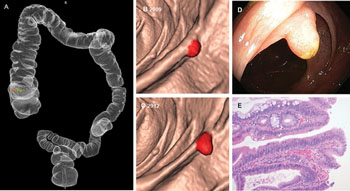Study Reveals the Value of CT Colonography in Determining the Growth of Polyps
By MedImaging International staff writers
Posted on 13 Jan 2016
Volumetric measurements of the evolution of medium-sized polyps may better inform clinicians in the management of the polyps than linear measurements.Posted on 13 Jan 2016
The volumetric measurements were helpful in determining whether a patient needed a colonoscopy, or whether surveillance using Computed Tomography Colonography (CTC) was sufficient. The research was carried out at the University of Amsterdam (Amsterdam, The Netherlands) and presented at the annual Radiological Society of North America (RSNA 2015) meeting in Chicago (IL, USA).

Image: Computed Tomography Colonography (CTC) of a progressing advanced adenoma polyp in the ascending colon on 3D images (Photo courtesy of RSNA).
The study had 70 participants, each with one or two 6–9 mm polyps, identified during primary CTC screening CTC. The patients underwent an additional CTC screening three year later. Patients with 6 mm or larger lesions had the opportunity to undergo colonoscopy and polypectomy. During the CTC screening exams semi-automated volumetric measurements were performed, and mean volume calculated for prone and supine volume measurements.
Polyps whose volume increased more than 30% were classified as progressing, while those that decreased more than 30% were classed as regressing. Polyps between those parameters were classed as stable. The researchers then correlated Polyp growth to histopathological findings. Thirty-five percent out of a total of 95 polyps found in the initial CTC were found to have progressed. A total of 38% of the polyps remained stable, 27% regressed, and 14% were completely resolved. During the surveillance interval none of the polyps were found to have progressed to colorectal cancers or adenomas with high-grade dysplasia.
The presenter of the study, Charlotte Tutein Nolthenius, MD, Department of Radiology, Academic Medical Center, University of Amsterdam, said, "Previous literature showed a 3–6.6% chance of harboring advanced histology for medium-sized (6–9 mm) polyps, but little is known about their natural course. CTC is probably the best method for determining longitudinal growth of these polyps, because we leave them in place allowing a reproducible localization and measurement.
Related Links:
University of Amsterdam














